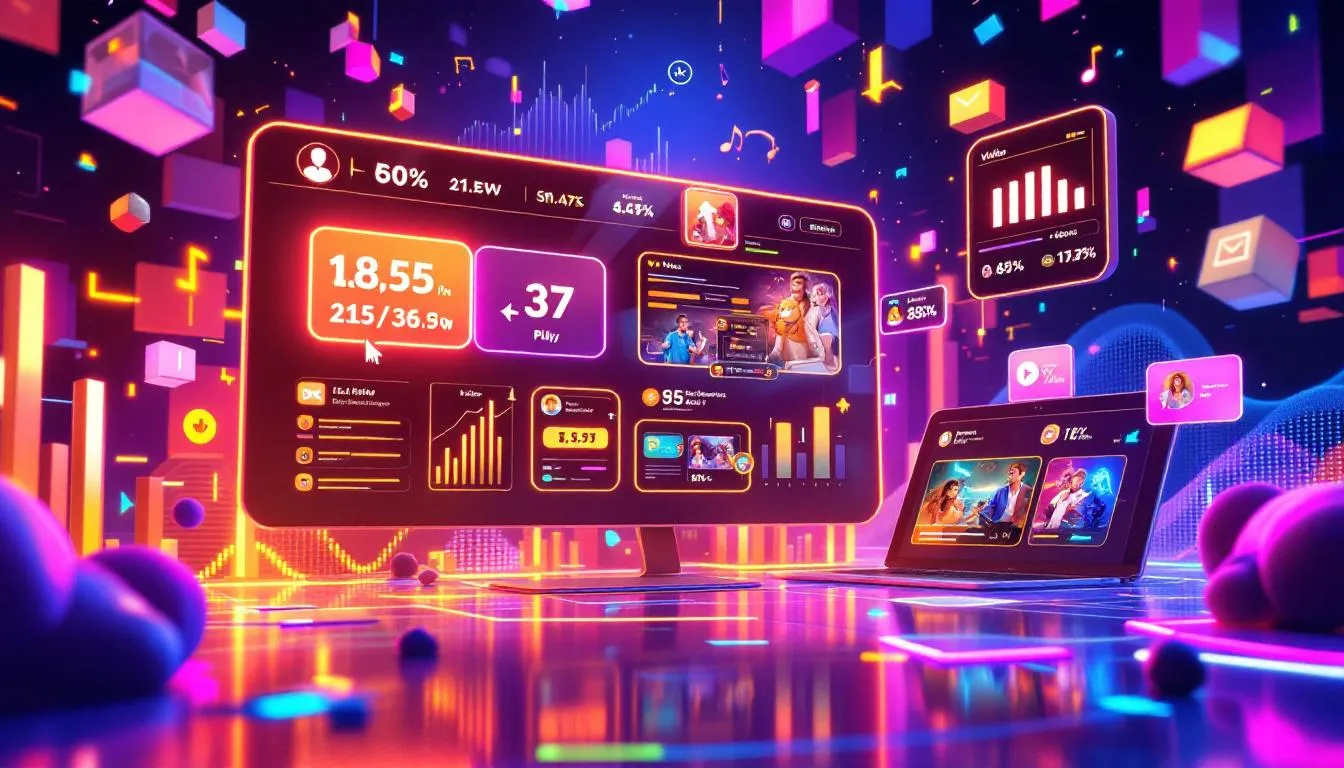Top Video Marketing Strategies to Boost Your Business in 2025
Video marketing uses videos to promote products or services online. It’s a crucial tool for engaging audiences and driving growth. This article outlines key strategies for successful video marketing in 2025.
Key Takeaways
Video marketing is essential for business growth, utilizing various formats to engage audiences effectively across digital platforms.
Developing a tailored video marketing strategy requires clear goals, understanding the target audience, and managing budgets efficiently.
Measuring key metrics such as engagement rates, view counts, and conversion rates is crucial for optimizing video marketing efforts and achieving desired business outcomes.
Understanding Video Marketing
Video marketing promotes products or services through digital video content marketing across digital channels. As a highly effective technique, it engages audiences and reaches customers on popular platforms. Consumers of all ages prefer online videos over other content forms, highlighting video content’s dominance.
Strategies may feature various video types, including:
Explainer videos
Brand videos
Customer testimonials
Educational videos
Tailoring these to specific business goals and target audiences makes video a versatile marketing tool.
Recognizing video marketing important is vital for businesses aiming to thrive digitally. Success lies in producing engaging, high-quality videos that resonate with your audience and prompt action.
What is Video Marketing?
Video marketing uses marketing videos to promote products or services across digital platforms. This involves creating content for social media, websites, and other online channels to engage and inform potential customers, especially for video marketers in a video marketing campaign.
An effective strategy provides valuable content that engages audiences and builds brand image. Whether introducing your company’s mission or detailing how your product solves a problem, video campaigns aim to create a lasting impact.
Benefits of Video Marketing
Around two-thirds of consumers prefer video content to learn about products or services. This preference highlights the importance of video consumption marketing for brands seeking deeper audience connections. Videos engage with visuals and sound, simplifying complex messages.
Video content is the second most popular on social media and particularly effective for boosting engagement. Incorporating videos into your social media marketing strategy enhances blogs, offers behind-the-scenes looks, and creates vlogs, fostering authentic connections through social media posts.
Videos boost search engine optimization by:
Keeping users engaged longer, improving rankings.
Building audience trust through authentic video marketing, encouraging brand engagement.
Enhancing brand authority and credibility with expert interviews and user-generated content.
Developing an Effective Video Marketing Strategy
Creating an effective video marketing strategy maximizes impact. Consumer preference and platform prioritization of video content drive growth, making it vital for brands to stay updated with trends and regularly evaluate campaigns.
Aligning with broader business objectives and including clear steps defines a successful strategy. Key components include:
Budget
Timelines
Production processes
Conversion metrics
Regularly releasing branded content keeps up with industry growth and competition.
Start by listing some forbidden forms of the keyword “quick how to video” according to the rule 5. With the strategy in place, begin by video planning and creating videos based on the plan. Set clear goals, identify your target audience, and budget effectively to ensure a smooth quick how to video creation process.
Define Your Goals
Clear video marketing objectives are crucial for measuring campaign success. Specific, measurable goals gauge effectiveness and guide content creation. Defining clear objectives avoids wasting time and resources in production.
These goals will serve as a roadmap, ensuring that every aspect of your video aligns with your broader marketing strategy.
Identify Your Target Audience
The target audience in video marketing is defined by demographics and customer personas, crucial for relevant content creation. Understanding your audience starts with developing buyer personas to identify preferences and improve relevance.
Regularly asking for viewer input and utilizing feedback ensures your videos stay relevant and engaging. Timing is key; reaching your audience when they are most engaged maximizes content impact.
Budgeting for Video Marketing
High production value videos incur costs for talent, crew, and editing. However, brands can start on a budget using vertical video formats popularized by TikTok. Effective planning and project management save time and costs in production.
Strategically allocate budget based on where the highest-converting audience is for effective video distribution. Deciding what to create in-house versus outsourcing is critical when establishing a production budget.
Types of Video Content to Consider
Selecting the right type of video content is key to an effective strategy. Common types include explainer, customer testimonials, and educational videos. Additionally, businesses can produce branded videos, short films, and event coverage to engage audiences.
Video content choices should align with marketing goals and target audience preferences. Each type serves a unique purpose and can be tailored to meet specific objectives.
Explainer Videos
Explainer videos educate the audience about a company or brand, providing information on products or services. They highlight outcomes by demonstrating how the business resolves issues. By addressing key questions—what problem the audience faces, how the product/service fixes it, and why to choose us—an explainer video effectively communicates value.
Animation in short form video animated video explainer videos engages the audience and explains complex concepts in a relatable way. Typically concise, under three minutes, these videos effectively hold viewer attention.
Customer Testimonial Videos
Customer testimonial videos influence customers by showcasing real people discussing a product or service. They enhance credibility by providing genuine accounts that resonate with potential clients.
Brands collect testimonials by asking customers, polling in-store, or sharing customer-generated videos. The emotional connection in testimonial videos can be stronger than online reviews.
Educational Videos
Educational videos like how-to guides or tutorials teach the audience and build foundational business knowledge. About 31.3% of users prefer how-to videos, highlighting their importance.
Brands develop educational videos by focusing on topics related to their brand and audience interests. A library of educational content videos caters to self-service consumers, allowing them to learn at their own pace.
Creating Compelling Video Content
Creating compelling video content starts with finalizing your video marketing strategy. The right video style significantly impacts tone and messaging, affecting audience engagement.
To improve live video engagement and post production:
Encourage engagement during live videos by responding to comments.
Use concise content to enhance engagement by delivering key messages quickly.
Practice and patience are essential for improving video production.
Storytelling Techniques
A narrative in videos emotionally connects with viewers and improves retention. Consider desired viewer emotions when telling a story to ensure it resonates with the video footage.
Select props, locations, colors, and wardrobe that communicate the intended emotion for effective storytelling. Engagingly telling brand values stories enhances viewer interest and drives conversions.
Technical Aspects
Technical aspects are crucial for high-quality videos. Maintain a resolution of at least 1920 x 1080 for quality footage. High-quality visuals and audio together provide a polished viewer experience.
Three-point lighting manages shadows and creates a balanced look in videos. Quality audio equipment significantly enhances the overall viewer experience and keeps viewers engaged.
Leveraging User-Generated Content
User-generated content fosters authenticity and builds a community around a brand. Encouraging customers to create and share content related to your brand enhances engagement and provides valuable social proof, ultimately driving organic traffic.
Incorporating user-generated content into video marketing campaigns reduces production costs and increases available content in the post production process to create video marketing content for distribution.
Distributing Your Video Content
Effective video distribution enhances audience reach and engagement. Wisely using distribution channels maximizes visibility. Owned channels like your website and email lists allow you to control and test the content you publish.
Earned distribution relies on chance, encouraged through social sharing and influencer marketing partnerships. Paid channels, like targeted ads, increase exposure by reaching a wider audience.
Social Media Platforms
Different social media platforms cater to varying audience preferences and content types. Use Instagram for personal branding with short-form, mobile-optimized videos, and LinkedIn for B2B marketing through industry news and updates.
Favor vertical videos for Facebook Stories and keep them concise for higher retention. Sharing valuable, resonant short form video content enhances engagement through facebook video ads.
Video Hosting Platforms
YouTube is the second-most popular website, with over five billion videos watched daily by internet users. You can watch online videos while watching videos online by uploading content for free to your youtube channel, which supports consistent content uploads, favored by the algorithm, including your own sponsored video, online video, and youtube video.
Vimeo is popular for high-quality content and commonly used for embedding marketing assets on websites. Vidyard provides tools for businesses to create, host, and share videos effectively.
Paid Distribution Channels
Paid distribution channels are necessary for visibility on many platforms, including various marketing channels. Types include social media ads, like sponsored posts on Facebook, Instagram, and YouTube.
Paid video ads allow precise targeting based on demographics and interests, enhancing effectiveness. Using effective paid distribution methods substantially increases the reach and impact of video marketing efforts.
Measuring Success in Video Marketing
Measuring your video marketing strategy’s success is crucial for understanding its impact and making adjustments. Key metrics include:
Impressions
Click-through rates
Conversions
Audience retention
Platform data simplifies performance analysis by consolidating metrics into actionable insights.
Regularly assessing viewer engagement metrics guides strategic improvements. Refining content based on audience preferences and performance analytics enhances campaign effectiveness.
Regularly evaluating video performance leads to strategic adjustments that optimize future marketing efforts.
View Count and Play Rate
View count indicates how often users watch your video, representing engagement level and reach. Tracking view count increases brand awareness, but balancing it with play rate is crucial for true engagement. Play rate is the percentage of viewers who played the video out of total impressions.
A low play rate indicates the content may not be relevant or appealing, while a high rate shows it is engaging enough to prompt viewers to click play. Focusing on both metrics provides a comprehensive view of performance.
Engagement Metrics
Key metrics to measure engagement in video marketing include:
Watch time
View-through rate
Comments
Shares
Social shares indicate the relevance of video content to the target audience. A low completion rate suggests that the content may not resonate well with the audience, while high completion rates reveal effective content that keeps viewers interested.
Engagement metrics help you understand how viewers interact with your videos and provide insights into what content resonates most. This information is invaluable for refining your video marketing strategy and creating more engaging video content.
Conversion Rate
Conversion rates measure how effectively video content translates views into actionable results like sales or sign-ups. Providing viewers with a clear call to action after watching a video is essential for driving conversions. For instance, HP achieved significant growth in impressions, clicks, and purchase rates with their video campaign.
By focusing on conversion rates, you can determine the direct impact of your video marketing efforts on your business goals. This metric is crucial for understanding the return on investment of your video marketing campaigns.
Optimizing Your Video Marketing Efforts
Optimizing your video marketing efforts is essential for continuous improvement and achieving better results. Analyzing completion rates can help gauge video viewers’ reaction and identify if content resonates with your audience. Maintaining viewer attention indicates they may need more information before making a decision.
Areas you can optimize in your video marketing strategy include distribution, understanding your target audience, and refining video content. Improving video marketing efforts over time can be achieved by examining conversion rates and addressing content gaps.
Repurposing Video Content
Repurposing video content saves time and resources while reaching different audiences across various platforms. It can boost your return on investment (ROI) by extending the life and reach of your existing videos. Methods for repurposing include editing software longer videos into shorter clips, creating teasers for social media, and compiling videos into a highlights reel.
Consider adapting video content to different formats such as podcasts or blog posts to cater to various audience preferences. Repurposing content allows you to maximize the value of your video marketing efforts.
A/B Testing
A/B testing is crucial for optimizing video marketing strategies, as it allows marketers to identify which video elements resonate most with their audience. To execute A/B tests on video content, marketers should create two versions of a video with varying elements like length, visuals, or call-to-action placements.
It is essential to run A/B tests with a significant sample size to ensure reliability in the results and enable accurate performance comparisons. Once A/B tests are completed, analyzing metrics such as engagement rates and viewer feedback is vital for understanding which version performed best.
Incorporating Feedback
Incorporating audience feedback is crucial in video marketing as it allows brands to adjust their strategies based on audience interaction. Using viewer feedback effectively helps improve the quality and relevance of video content, leading to better audience engagement.
For instance, Wells’ team engaged their audience by responding with a video to a popular comment on TikTok, showcasing how they value viewer input. Gathering and acting on feedback helps create content that truly resonates with your audience.
Summary
Video marketing in 2025 is an essential component of a successful digital strategy. By understanding what video marketing is, its benefits, and how to develop an effective strategy, businesses can create compelling content that resonates with their target audience. Measuring success and continuously optimizing efforts are key to maintaining the effectiveness of video marketing campaigns.
In conclusion, leveraging video marketing strategies can significantly boost your business. From creating engaging video content to distributing it effectively and measuring its impact, each step plays a crucial role in achieving your marketing goals. By staying updated with trends and continuously refining your approach, you can harness the full potential of video marketing.
Frequently Asked Questions
What is video marketing?
Video marketing is the use of video content to promote products or services, effectively engaging audiences and enhancing brand recognition. It’s a powerful tool for reaching customers across digital platforms.
Why is video marketing important in 2025?
Video marketing will be crucial in 2025 due to its effectiveness in engaging consumers of all ages and enhancing SEO strategies. Embracing video content can significantly elevate your marketing efforts.
How do I develop an effective video marketing strategy?
To develop an effective video marketing strategy, define clear objectives, identify your target audience, and budget accordingly for production. Regularly evaluate and update your campaigns to ensure alignment with your overall business goals.
What types of video content should I consider for my marketing strategy?
Incorporating a mix of explainer videos, customer testimonials, educational content, branded videos, and event coverage into your marketing strategy can effectively meet diverse objectives and engage your audience. Tailoring each type to your goals will enhance your overall impact.
How can I measure the success of my video marketing efforts?
To effectively measure the success of your video marketing efforts, focus on key metrics like view count, engagement rates, and conversion rates. Regular analysis of these metrics will help you optimize your strategy for better results.
Why Work with The Desire Company
Looking to elevate your video marketing strategy in 2025? The Desire Company helps brands turn video content into a conversion powerhouse. We produce expert-led product videos designed to drive results, boosting purchase confidence, increasing engagement, and lowering return rates.
Our proprietary content model is trusted by leading retailers and proven to deliver up to 12x higher conversion rates and a 25% increase in average order value. Whether you're looking to scale content for PDPs, email campaigns, paid ads, or social platforms, our videos are designed to work across every touchpoint.
What sets us apart:
Experts, not influencers. Our content is powered by real pros such as chefs, athletes, makeup artists, and more who bring deep credibility and authentic insight.
Fast production timeline. Our end-to-end video production process takes just 4 to 6 weeks from concept to delivery.
Compliance-ready content. Every video meets FTC guidelines for honest, transparent endorsements.
Want to see how expert-led content can amplify your brand? Explore our work or schedule a free strategy session today.













